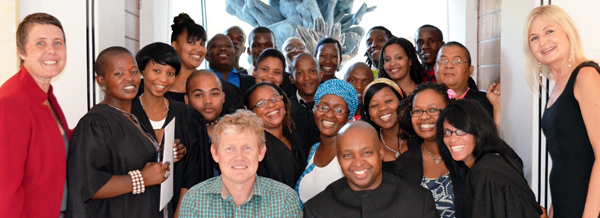 |
|
The first group of journalists who completed the Department of Communication Science’s short-learning programme for community journalists. The course was developed by Mrs Willemien Marais (far left) and Mrs Margaret Linström (far right). In front in the middle are Prof Lucius Botes, Dean of the Faculty of the Humanities, and Mr Lumko Mtimde, CEO of the Media Development and Diversity Agency, the sponsor of the programme. Fifth from right is Ms Manana Monareng Wa Stone, Programme Manager of the MDDA. |
An investment in our people, our region and our democracy. This is the value of the Department of Communication Science’s short-learning programme for community journalists.
The first 20 community journalists from radio stations and newspapers in the Free State and Northern Cape received their certificates recently after successfully completing the course Basic Journalism Skills for Community Media.
This credit-bearing short-learning programme is fully sponsored by the Media Development and Diversity Agency (MDDA), a statutory body with the aim of developing and promoting community media.
The University of the Free State (UFS) is the first university in South Africa that presents a course of this nature. “It is also the first large-scale formal training of community journalists in the Free State and Northern Cape,” says Mrs Margaret Linström, journalism lecturer in the Department of Communication Science. She developed the course together with another journalism lecturer in the Department, Mrs Willemien Marais. “What distinguishes our programme for similar programmes is the element of mentoring,” explains Marais. Students attend a week-long training session on the Bloemfontein Campus of the UFS. The lecturers then visit all the participating newsrooms to provide further training in terms of the unique challenges of their area. “During the second semester we’ve travelled more than 3000 km to visit radio stations and newspapers as far afield as Springbok and Phuthaditjhaba,” says Linström.
During the certificate ceremony the CEO of the MDDA, Mr Lumko Mtimde, said this partnership with the UFS has the potential to make a tangible difference in communities. “Combined community media reaches the largest target audience in the country. Against this background the importance of training community journalists becomes very clear,” says Mtimde.
The role of community journalists differ from that of journalists who work for state or commercial media. Yet most of these community journalists fall outside the network of formal training, mostly due to a lack of resources and access to training.
“This course has changed my life. I came back as a newborn baby for whom everything is new!” said Mr Setona Selisa from Naledi FM in Senekal. Selisa and his colleague, Mr Teboho Mabuya, received the award for the best participants of the 2013 course.